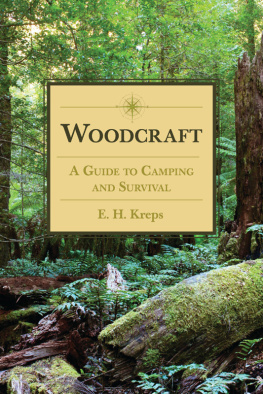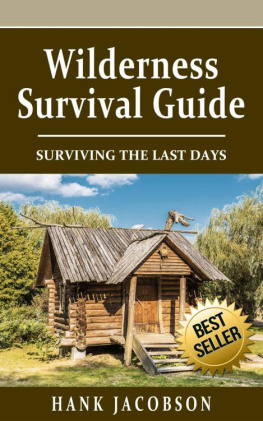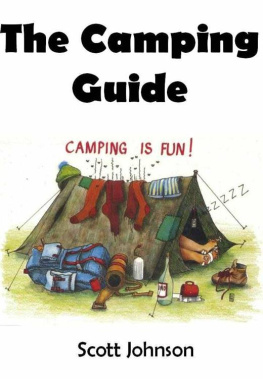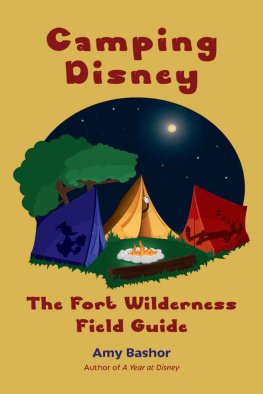WOODCRAFT
WOODCRAFT
A Guide to Camping and Survival

by
E.H. KREPS

Copyright 2013 by Skyhorse Publishing, Inc.
All Rights Reserved. No part of this book may be reproduced in any manner without the express written consent of the publisher, except in the case of brief excerpts in critical reviews or articles. All inquiries should be addressed to Skyhorse Publishing, 307 West 36th Street, 11th Floor, New York, NY 10018.
Skyhorse Publishing books may be purchased in bulk at special discounts for sales promotion, corporate gifts, fund-raising, or educational purposes. Special editions can also be created to specifications. For details, contact the Special Sales Department, Skyhorse Publishing, 307 West 36th Street, 11th Floor, New York, NY 10018 or info@skyhorsepublishing.com.
Skyhorse and Skyhorse Publishing are registered trademarks of Skyhorse Publishing, Inc., a Delaware corporation.
Visit our website at www.skyhorsepublishing.com.
10 987654321
Library of Congress Cataloging-in-Publication Data is available on file.
ISBN: 978-1-62087-481-3
Printed in the United States of America
CONTENTS
PREFACE
Elmer H. Kreps was born in Union county, Pa., in 1880. At that time large and small game of the various species common to Central Pennsylvania was plentiful in the neighborhood of his home. From his early boyhood he took a great interest in hunting and trapping. As he grew older he visited various parts of the United States and Canada, and being a keen observer, picked up a vast amount of information about life in the woods and fields.
Mr. Kreps has written many articles on various subjects connected with hunting and trapping and this little booklet is a collection of Woodcraft articles from his pen. Mr. Kreps is an accomplished artist as well as writer, and the illustrations in Woodcraft are reproduced from his sketches.
We feel sure that this collection of articles will prove of value to many men and boys who are interested in living in the woods and no one will be more happy than Mr. Kreps if his work helps brighten the life of trappers and hunters, in whom he is always interested.
EDITOR FUR NEWS
BUILDING THE HOME CAMP
The first camp I remember making, or remodeling, was an old lumber camp, one side of which I partitioned off and floored. It was clean and neat appearing, being made of boards, and was pleasant in warm weather, but it was cold in winter, so I put up an extra inside wall which I covered with building paper. Then I learned the value of a double wall, with an air space between, a sort of neutral ground where the warmth from the inside could meet the cold from without, and the two fight out their differences. In this camp I had a brick stove with a sheet iron top, and it worked like a charm.
But that was not really a wilderness camp, and while I realize that in many of the trapping districts where it is necessary to camp, there are often these deserted buildings to be found, those who trap or hunt in such places are not the ones who must solve the real problems of camp building. It is something altogether different when we get far into the deep, silent forest, where the sound of the axe has never yet been heard, and sawed lumber is as foreign as a linen napkin in a trappers shack. But the timber is there, and the trapper has an ax and the skill and strength to use it, so nothing more is really needed. Let us suppose we are going to build a log cabin for a winter's trapping campaign. While an axe is the only tool necessary, when two persons work together, a narrow crosscut saw is a great labor-saver, and if it can be taken conveniently the trappers or camp builders will find that it will more than pay for the trouble. Other things very useful in this work are a hammer, an auger, a pocket measuring tape, and a few nails, large, medium and small sizes. Then to make a really pleasant camp a window of some kind must be provided, and for this purpose there is nothing equal to glass.
Right here a question pops up before us. We are going on this trip far back into the virgin forest, and the trail is long and rough; how then can we transport an unwieldy crosscut saw and such fragile stuff as glass? We will remove the handles from the saw and bind over the tooth edge a grooved strip of wood. This makes it safe to carry, and while still somewhat unhandy it is the best we can do, for we cannot shorten its length. For the window, we will take only the glasssix sheets of eight by ten or ten by fourteen size. Between each sheet we place a piece of corrugated packing board, and the whole is packed in a case, with more of the same material in top and bottom. This makes a package which may be handled almost the same as any other merchandise, and we can scarcely take into the woods anything that will give greater return in comfort and satisfaction.
If we are going to have a stove in this cabin we will also require a piece of tin or sheet iron about 18 inches square, to make a safe stovepipe hole, but are we going to have a stove or a fireplace? Let us consider this question now.
On first thought the fireplace seems the proper thing, for it can be constructed in the woods where the camp is made, but a fireplace so made may or may not be satisfactory. If we know the principles of proper fireplace construction we can make one that will not smoke the camp, will shed the proper amount of heat, and will not consume more fuel than a well-behaved fireplace should, but if one of these principles be violated, trouble is sure to result. Moreover, it is difficult to make a neat and satisfactory fireplace without a hammer for dressing the stones, and a tool of this kind will weigh as much as a sheet iron stove, therefore it is almost as difficult to take into the woods. Then there is one or two days' work, perhaps more, in making the fireplace and chimney, with the added uncertainty of its durability, for there are only a few kinds of stones that will stand heat indefinitely without cracking. On the other hand the fireplace renders the use of a lamp unnecessary, for it will throw out enough light for all ordinary needs.
The good points of the stove are that it can be made by anybody in a half day's time; it does not smoke the camp, does not black the cooking utensils, gives the maximum amount of heat from the minimum quantity of fuel, and will not give out or go bad unexpectedly in the middle of the winter. If you leave it to me our camp will be equipped with a sheet iron stove. While the stove itself is not now to be considered, we must know before we commence to build what form of heating and cooking apparatus will be installed.

CHART SHOWING LOCATION OF CAMP
Having decided on which part of the country is to be the centre of operations, we look for a suitable site for our cabin. We find it near a stream of clear water. Nearby is a stretch of burned land covered thinly with second growth saplings, and near the edge of the evergreen forest in which we will build our camp stands plenty of dead timber, tamarack, white spruce, and a few pine stubs, all of which will make excellent firewood. In the forest itself we find straight spruce trees, both large and small, balsam, and a few white birches, the loose bark of which will make the best kindling known. Within three rods of the stream and 50 yards from the burn is a rise of ground, high enough to be safe from the spring freshets, and of a gravelly ground which is firm and dry. This is the spot on which we will construct our cabin, for here we have good drainage, shelter from the storms, water and wood near at hand, and material for the construction of the camp right on the spot.
Next page












